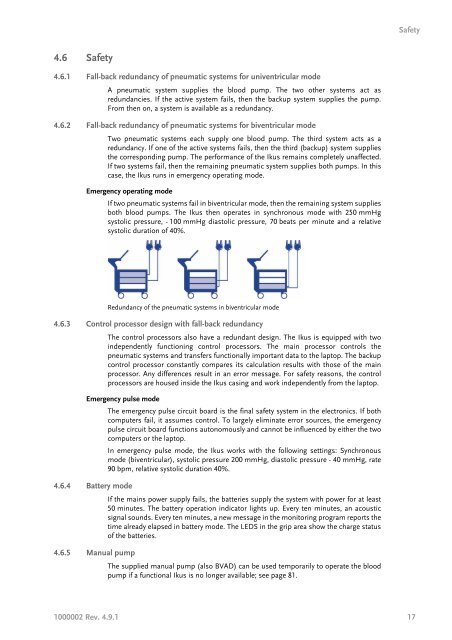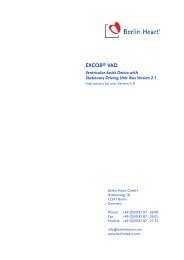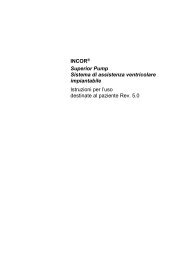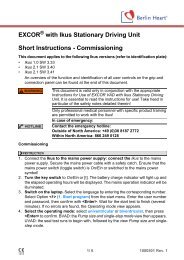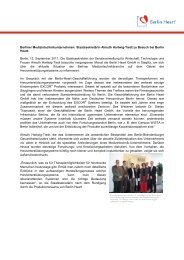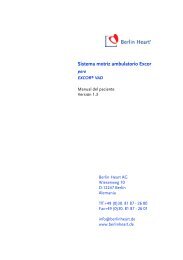Instructions for use: Ikus - Berlin Heart
Instructions for use: Ikus - Berlin Heart
Instructions for use: Ikus - Berlin Heart
Create successful ePaper yourself
Turn your PDF publications into a flip-book with our unique Google optimized e-Paper software.
4.6 Safety<br />
4.6.1 Fall-back redundancy of pneumatic systems <strong>for</strong> univentricular mode<br />
A pneumatic system supplies the blood pump. The two other systems act as<br />
redundancies. If the active system fails, then the backup system supplies the pump.<br />
From then on, a system is available as a redundancy.<br />
4.6.2 Fall-back redundancy of pneumatic systems <strong>for</strong> biventricular mode<br />
Two pneumatic systems each supply one blood pump. The third system acts as a<br />
redundancy. If one of the active systems fails, then the third (backup) system supplies<br />
the corresponding pump. The per<strong>for</strong>mance of the <strong>Ikus</strong> remains completely unaffected.<br />
If two systems fail, then the remaining pneumatic system supplies both pumps. In this<br />
case, the <strong>Ikus</strong> runs in emergency operating mode.<br />
Emergency operating mode<br />
If two pneumatic systems fail in biventricular mode, then the remaining system supplies<br />
both blood pumps. The <strong>Ikus</strong> then operates in synchronous mode with 250 mmHg<br />
systolic pressure, - 100 mmHg diastolic pressure, 70 beats per minute and a relative<br />
systolic duration of 40%.<br />
Redundancy of the pneumatic systems in biventricular mode<br />
4.6.3 Control processor design with fall-back redundancy<br />
The control processors also have a redundant design. The <strong>Ikus</strong> is equipped with two<br />
independently functioning control processors. The main processor controls the<br />
pneumatic systems and transfers functionally important data to the laptop. The backup<br />
control processor constantly compares its calculation results with those of the main<br />
processor. Any differences result in an error message. For safety reasons, the control<br />
processors are ho<strong>use</strong>d inside the <strong>Ikus</strong> casing and work independently from the laptop.<br />
Emergency pulse mode<br />
The emergency pulse circuit board is the final safety system in the electronics. If both<br />
computers fail, it assumes control. To largely eliminate error sources, the emergency<br />
pulse circuit board functions autonomously and cannot be influenced by either the two<br />
computers or the laptop.<br />
In emergency pulse mode, the <strong>Ikus</strong> works with the following settings: Synchronous<br />
mode (biventricular), systolic pressure 200 mmHg, diastolic pressure - 40 mmHg, rate<br />
90 bpm, relative systolic duration 40%.<br />
4.6.4 Battery mode<br />
4.6.5 Manual pump<br />
If the mains power supply fails, the batteries supply the system with power <strong>for</strong> at least<br />
50 minutes. The battery operation indicator lights up. Every ten minutes, an acoustic<br />
signal sounds. Every ten minutes, a new message in the monitoring program reports the<br />
time already elapsed in battery mode. The LEDS in the grip area show the charge status<br />
of the batteries.<br />
The supplied manual pump (also BVAD) can be <strong>use</strong>d temporarily to operate the blood<br />
pump if a functional <strong>Ikus</strong> is no longer available; see page 81.<br />
Safety<br />
1000002 Rev. 4.9.1 17


